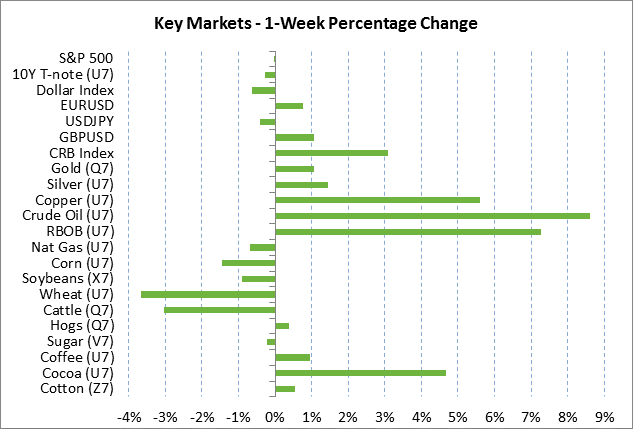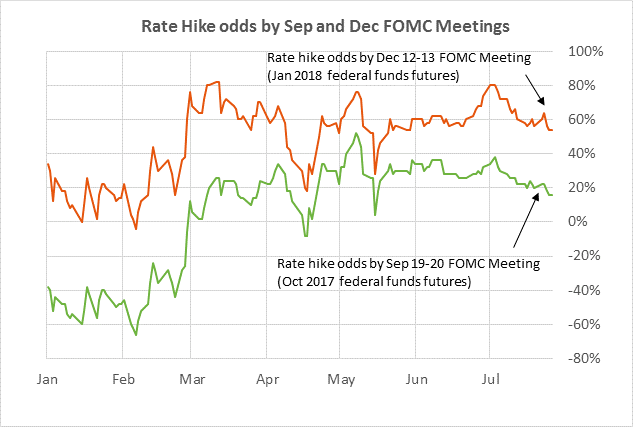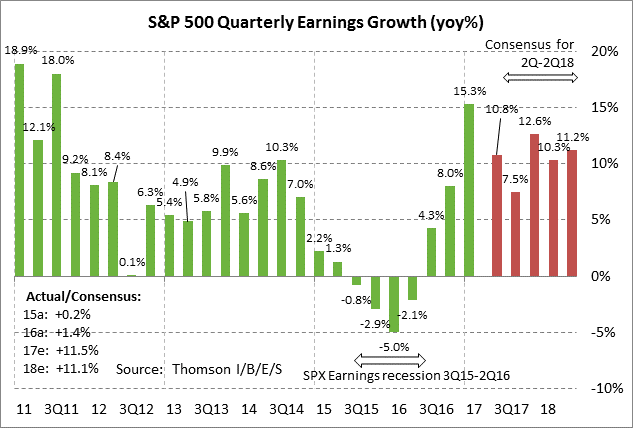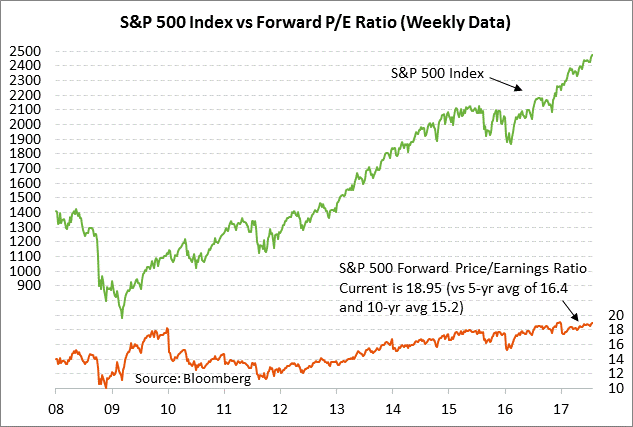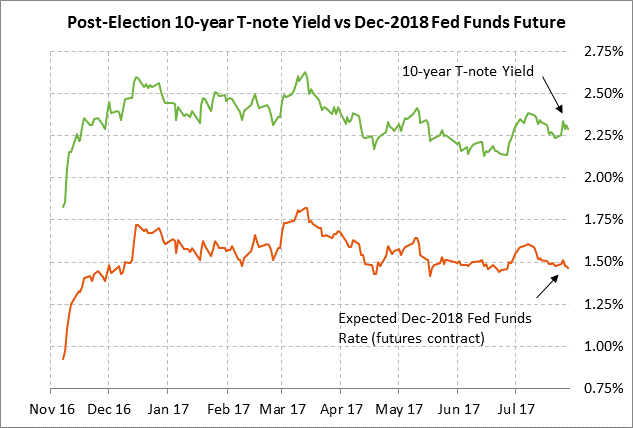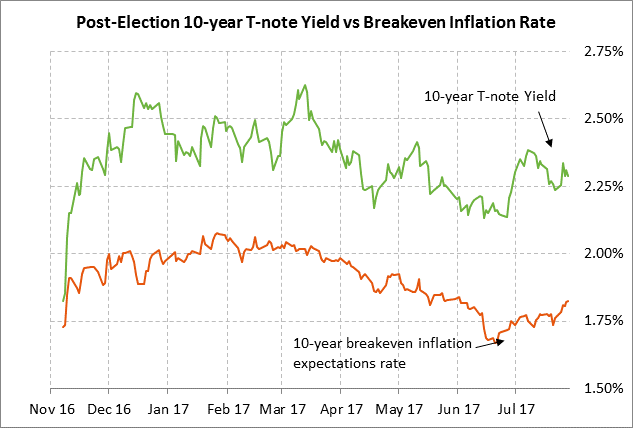- Weekly U.S. market focus
- Fed policy outlook could shift this week with deflator and wage reports
- Another big Q2 earnings week
- U.S. stocks hit record high but then get jumpy
- T-notes face inflation data and refunding announcement this week
Weekly U.S. market focus — The U.S. markets this week will focus on (1) any further gyrations in tech stocks that have recently been roiling the stock market, (2) this week’s busy U.S. economic calendar that culminates with Friday’s June payroll report (expected +180,000), (3) some light Fedspeak with Loretta Mester and John Williams (both non-voters) speaking on Wednesday at separate events, and (4) whether crude oil prices extend their month-long rally, thus providing further support for energy stocks and inflation expectations. The 10-year breakeven inflation expectations rate last week rose by +6 bp to 1.82, posting a new 2-month high.
The markets this week will continue to closely watch events in Washington as former Homeland Security Secretary John Kelly takes over as the new Chief of Staff at the White House. The House recessed last Friday for the month of August. However, the Senate will remain in session this week and next week in order to work on executive and judicial nominations and a backlog of other business. President Trump this week will undoubtedly try to keep the pressure on Senate Republicans to return to the health care debate to see if they can find some way to revive the Obamacare repeal effort even after Senate Majority Leader McConnell last Thursday said it was time to move on to other business.
Geopolitics will remain in the news this week after Russia retaliated for U.S. sanctions and after North Korea on Friday launched another ICBM missile with enough range to reach the continental U.S. The Trump administration may be planning more concrete action against China to get Chinese officials to curb North Korea’s nuclear ambitions.
Fed policy outlook could shift this week with deflator and wage reports — The federal funds futures curve last week showed little change in the outlook for Fed rate hikes. The market is currently discounting the odds for a rate hike at 16% for the next FOMC meeting on Sep 19-20, 20% for the Oct 31/Nov 1 meeting, and 54% by the Dec 12-13 meeting. The market consensus is that the Fed is likely to announce the start date its balance sheet normalization program at its next meeting on Sep 19-20 and begin the program in October.
The outlook for Fed policy could shift a bit this week with Tuesday’s PCE deflator report and Friday’s payroll report and wage report. The Fed is taking the recent softness in the inflation statistics more seriously and weak inflation data this week would increase the Fed’s inflation confusion and reduce the odds for another Fed rate hike before year-end. The consensus is for Tuesday’s June PCE deflator to ease slightly to +1.3% y/y from May’s +1.4%, but for the core PCE deflator to be unchanged from May’s +1.3% y/y. The consensus is for Friday’s July average hourly earnings report to ease slightly to +2.4% y/y from June’s +2.5%.
The Treasury at its quarterly refunding announcement on Wednesday may announce how it plans to increase issuance once the Fed begins its balance sheet normalization program and steps away as a big buyer of Treasury securities. The Treasury could keep the increased issuance in short-term T-bills, or it could spread it out across the coupon curve, thus putting some upward pressure on T-note yields.
Another big Q2 earnings week — This will be the second biggest earnings week, behind last week, with 134 of the S&P 500 companies scheduled to report. Notable reports include Apple on Tuesday, Time Warner on Wednesday, and Berkshire Hathaway on Thursday.
The market consensus for Q2 SPX earnings growth has now risen to +10.8% y/y (+8.2% ex-energy) from expectations of +8.0% just a month ago on July 1, according to Thomson Reuters I/B/E/S. Of the reporting companies, 73.0% have beaten earnings expectations, above the long-term average of 64% and the 4-quarter average of 71%. On revenue, 70.9% of reporting companies have beaten the consensus, much better than the long-term average of 59% and the 4-quarter average of 56%.
Looking forward, the consensus is for SPX earnings growth of +7.5% in Q3, +12.6% in Q4, +10.3% in Q1-2018, and +11.2% in Q2. On a calendar year basis, the consensus is for strong SPX earnings growth of +11.5% in 2017 and +11.1% in 2018.
U.S. stocks hit record high but then get jumpy — The S&P 500 index last Thursday rallied to a new record high. However, a sharp downdraft then appeared in the early afternoon on a minimal pretext that led to heavy selling in tech stocks. Amazon’s disappointing earnings news late Thursday then kept a damper on stocks on Friday.
The U.S. stock market has strong underlying support from the favorable Q2 earnings season and expectations for strong earnings through next year. However, high valuation levels mean that the stock market is priced for perfection and that it is vulnerable to downdrafts on any bad news. The forward P/E ratio for the S&P 500 index closed last week at 18.95, which is well above the 5-year average of 16.4 and the 10-year average of 15.2.
T-notes face inflation data and refunding announcement this week — The T-note market this week will be carefully watching the week’s inflation data, Wednesday’s Treasury refunding announcement, and Friday’s payroll report. The 10-year T-note yield last week rose by +5.1 bp to 2.89% mainly because of higher inflation expectations caused by the rally in crude oil prices to a new 2-month high. However, the market is anticipating low near-term volatility. The TYVIX last Friday closed the week at only 3.85%, just above the recent low of 5.64%.

